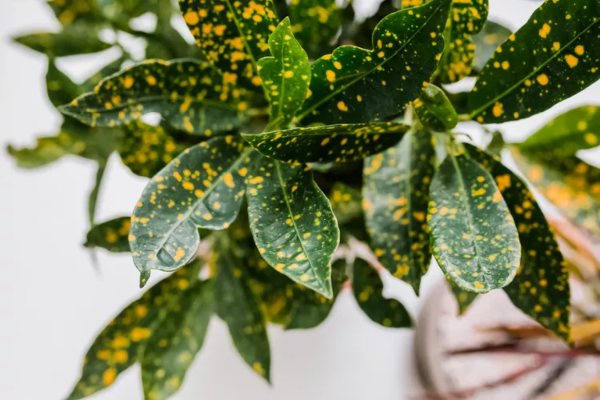Croton plants are colorfully variegated foliage and unlimited leaf forms with hundreds of croton varieties. These wonderful plants grow best outdoors in warm and humid environments. They love full to-shaded light and lots of water. Because of these reasons, growing crotons indoors can be a challenging task. Outdoors, these shrubs can grow around 8 feet tall. Growing them in pots tends to be much smaller, making them a good indoor plant. They grow relatively slowly, growing only a foot per growing season.
One of the first and biggest challenges of caring for crotons is maintaining the ideal temperature. If the place is too cold, they will start losing leaves. They are worth the effort for the pop of color they add to a boring space. Other benefits of crotons indoors are that they purify the air add humidity to a space, and improve mood and productivity.
Also, Read Container Gardening Made Easy: 10 Sun and Shade-Loving Low-Maintenance Plants
- Common Name: Crotons, garden crotons
- Botanical Name: Codiaeum variegatum
- Family: Euphorbiaceae
- Plant Type: Shrub
- Mature Size: 3–8 ft. tall, 3–6 ft. wide
- Sun Exposure: Full, partial
- Soil Type: Moist, well-drained
- Soil pH: Acidic
- Bloom Time: Spring, Summer, Fall, Winter
- Flower Color: Yellow
- Hardiness Zone: 11-12 USDA
- Native Place: Asia
- Toxicity: Toxic to pets and humans
How to care for Croton Plants?
One big thing to do for caring for Crotons is to provide steady warmth. A mature croton plant keeps its leaves down to the soil level. Even the Crotons outdoors will drop leaves after a cold night. They need bright sunlight to maintain their lively leaf colors.
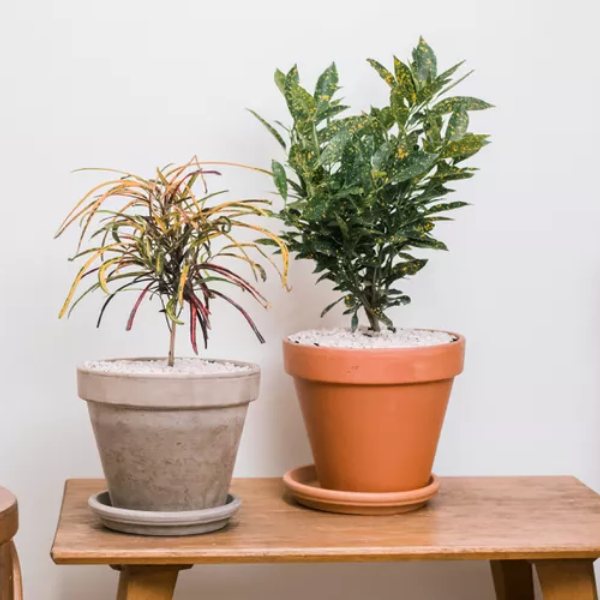
Indoors, crotons can get susceptible to spider mites if there is low humidity. To avoid any infestation, mist your plants daily. During warm weather, you can keep them outdoors and they will thrive as long as they have all the acclimated light and temperature conditions.
Planting
These shrubs should be planted in loose, well-draining soil. If your place’s night temperature goes below 50 degrees Fahrenheit at any time of the year, you must consider bringing your Croton pots indoors. Use a strong container that will be able to anchor the plant as it grows bigger. If you’re planning to keep it indoors, make sure that you place it by your brightest window. A good quality potting mix that drains well will do. Just ensure that the plant is protected from drafts around windows and doors.
Light
Croton plants need a good amount of sunlight i.e. bright, indirect light is best. Some varieties of it do not like unfiltered, direct sun as well as others. They do well in dappled sunlight. If the plant is having a light problem then the leaves will turn green.
Water
During summer, crotons loved getting evenly moist. They require about 1 inch of water per week. During winters, reduce watering to biweekly. If young foliage starts wilting, know that it is a sign that the plant needs more water. Increase the watering if the wilting happens during dry and hot weather. However, check the top couple of inches of soil with a finger for moisture before you water. If it is still moist, do not water. Misting frequently during the growth period is beneficial.
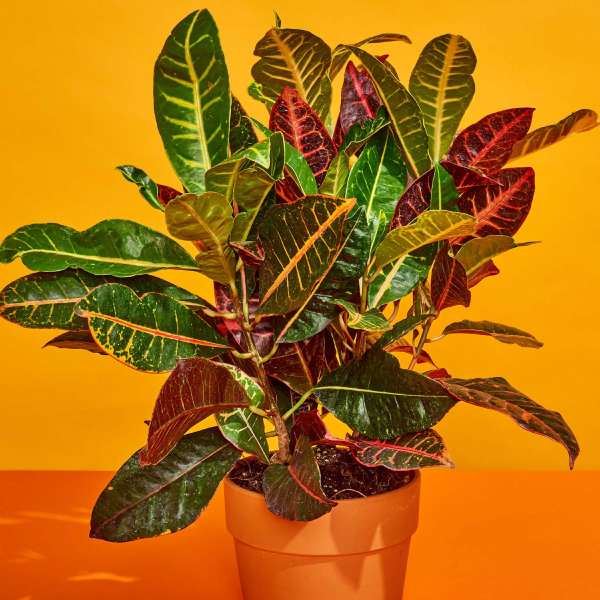
Soil
Since this plant cherishes humus-rich, acidic soil, a well-drained, moist soil that has been enriched with compost is perfect.
Temperature and Humidity
If your crotons are indoors, keep the room above 60 degrees Fahrenheit, and do not expose it to chilly drafts. Lack of humidity and bright light surely affects the leaf color. Keep the humidity level at 40 to 80 percent. If the humidity isn’t enough, the plant might drop leaves. If you’re not able to provide enough humidity to your plant at home, run a room humidifier or set a humidity tray beneath the plant and group it with other plants.
Fertilizer
During early spring, midsummer, and early fall, apply slow-release pellets. You can also use a liquid fertilizer every other month during the growing season from early March to the end of September. Since fertilizers vary by type, read the package instructions carefully.
Because Crotons are slightly acidic, acidifying fertilizers that contain ammonium nitrate, ammonium sulfate, or sulfur-coated urea.
Types of Crotons
As we mentioned above, there are hundreds of croton plant varieties like ‘Dreadlocks’, Ann Rutherford, Mona Lisa, and Irene Kingsley. For a plant with such diversity, it is impressive to know that there is only one species (Codiaeum variegatum). Each plant is unique because of its genetic instability and variability. These plants are classified by leaf type: Curling, twisted, oak leaf, narrow, broad, and oval. Some notable varieties are:
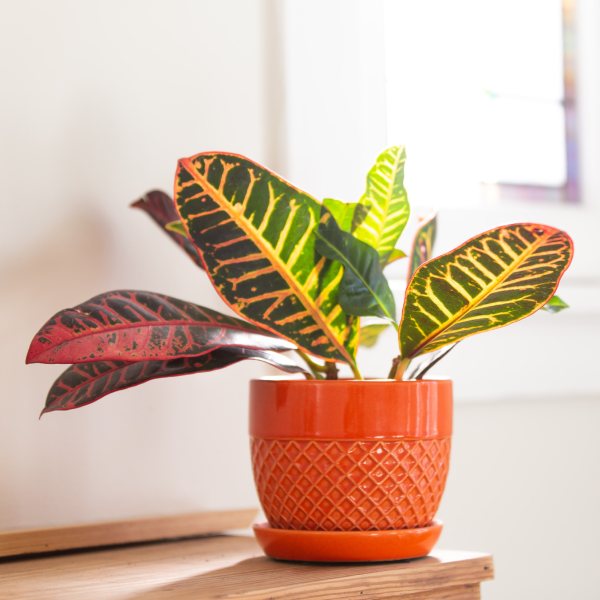
Codiaeum variegatum var. pictum: It has large, brightly colored leaves of orange, red, bronze, green, purple, and yellow; grows 3 to 6 feet tall as a houseplant.
Codiaeum variegatum ‘Gold Star’: It consists of narrow, linear leaves of green with bright yellow spotting. It has a tree-like habit and grows about 20 inches in height.
Codiaeum variegatum ‘Petra’: This variety has oval, green leaves with pronounced veining in pink, red, orange, and yellow hues; can reach 3 to 6 feet tall.
Do Crotons need pruning?
Crotons love pruning. So, if your plant becomes leggy, prune it at the start of the growing season. Cut off any unhealthy leaves and branches if you want to give it a specific shape. Trim it right above a node or leaf set. Do not remove more than 1/3 of the stem at a time. The plant will then grow from the cut portion. If you’re pruning your indoor Crotons, shift it outdoors once it’s been hardened off for almost a week.
Can we propagate Crotons?
We can propagate crotons any time of the year the most important factor is temperature. In tropical locales where the temperature is 70 to 80 degrees Fahrenheit, we can propagate croton plants year-round outdoors. You can also propagate indoors or in a greenhouse, maintaining correct temperatures.
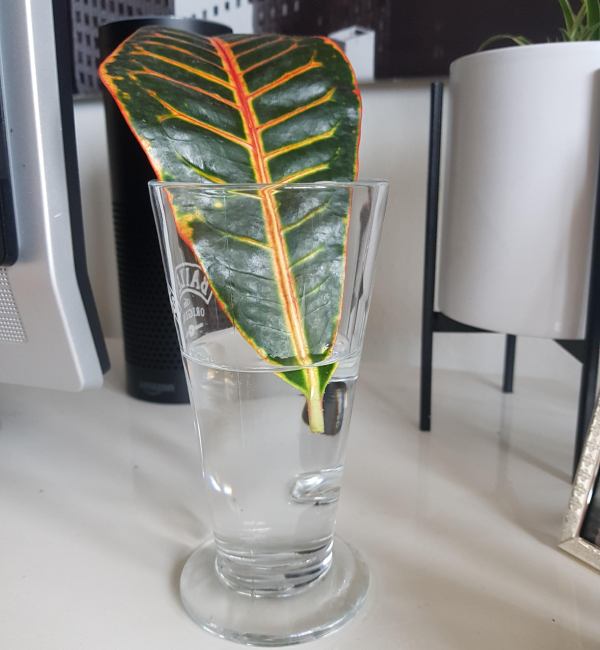
It is difficult to grow Crotons from seed, as the plant is unstable and the baby won’t have its parent’s qualities. They are normally propagated with stem cuttings. Stem cuttings help encourage new growth and will also control the size of the plant. With the help of a rooting hormone on your stem cut, you can increase the plant’s rooting success.
So, here is how you can propagate your crotons by division:
- Firstly, you will require sterile pruners, well-draining commercial potting soil, and a growing pot. Rooting hormone is optional. You do not need a container if you plant directly in the ground.
- Using the pruners, cut a 4- to 6-inch stem with the circumference of a pencil at a 45-degree angle right above a leaf node. Your cutting must have at least three leaves.
- If you’re using a rooting hormone, dip the cutting in it at the cut point.
- Plant the cutting in moist soil that is about 1 to 1.5 inches deep. Put the pot in a warm, sunny spot and away from cold drafts. Keep the soil moist but avoid overwatering. After a week, remove the plastic bag.
- Roots should grow in four weeks. Once the plant has developed new roots, transplant it to a larger pot or the spot in the ground.
Potting and repotting Crotons
Repot a baby croton every year at the beginning of the spring or summer for the first three growing seasons. After that, you only need to repot it when you need to i.e. when you notice the roots growing out of the drainage holes. The pot should be only a size larger than the plant’s current container. Put some damp peat-based potting soil into the bottom of the new container.
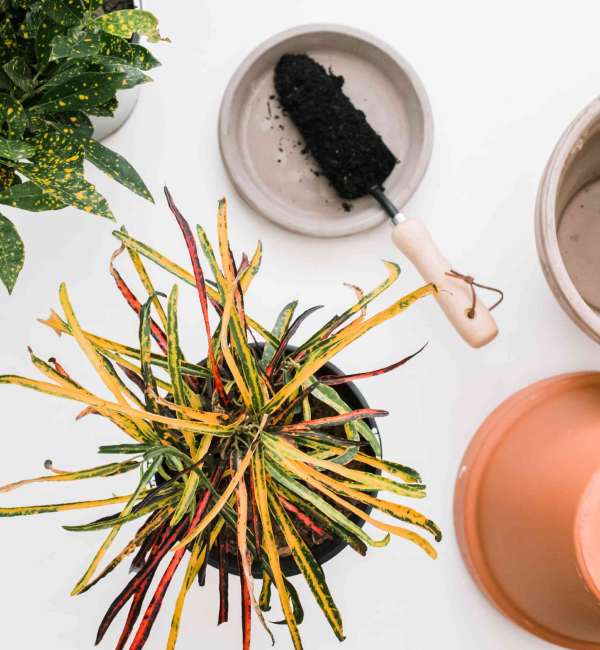
Gently slide the croton out of its old container and set it in its new home. Fill in around the roots with potting soil. Water the plants and add extra soil if required to bring the soil level to about an inch below the rim of its new pot.
Common pests and plant diseases
Crotons might get some plant diseases and pests. Crown gall is a common bacterial infection that affects this plant. It appears like thick, swollen growths on the stems and the veins of the leaves. If your croton catches this, you can pull up the plant, discard it, and sterilize the container and gardening tools. Be careful as it can spread to other plants as well.
Insects that might attack crotons are mealybugs, spider mites, scales, and thrips. You can use pesticides to remove these pests or some less harsh options like horticultural oil or insecticidal soap.
FAQs
Q: Is there an alternative for crotons?
A: One plant that is famous for its colorful foliage is the coleus plant. It comes in many color variations and is not that difficult to keep.
Q: Where should I keep crotons in my house?
A: This plant needs six to eight hours of direct sunlight to produce yellow, red, and purple foliage. You have to place it in an eastern, southern, or western exposure window to ensure that it gets enough sunlight.
Q: How long do they live?
A: Crotons’ average lifespan indoors is two to four years. You can take stem cuttings from your mature plant and propagate them to keep your plant outliving its lifespan. Crotons living outside in the correct environment will live longer.
Also, Read 10 Houseplants That Are Perfect For Your Kitchen!
